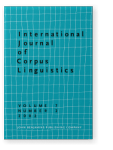Vol. 7:2 (2002) ► pp.137–164
HE and THEY in indefinite anaphora in written present-day English
This article explores the usage of singular HE and plural THEY with their possessive, objective and reflexive forms in anaphoric reference to compound indefinite pronouns in written present-day English. Previous studies have indicated that the most commonly used personal pronouns in anaphoric reference to non-referential indefinite pronouns are indeed HE and THEY. The data for the study are drawn from the written part of the British National Corpus. The structure of the study is such that following the introduction, I will survey the earlier literature on the topic to illustrate that there is a gap in the previous studies on epicene pronouns. The third section defines the indefinite pronouns used in this study. In addition, the section also discusses the differences between the meaning and form of the indefinites and the semantic reference sets of each pronoun paradigm. Following the explanation of the methods, the article sets out the findings.
Cited by
Cited by 5 other publications
This list is based on CrossRef data as of 1 june 2024. Please note that it may not be complete. Sources presented here have been supplied by the respective publishers. Any errors therein should be reported to them.
